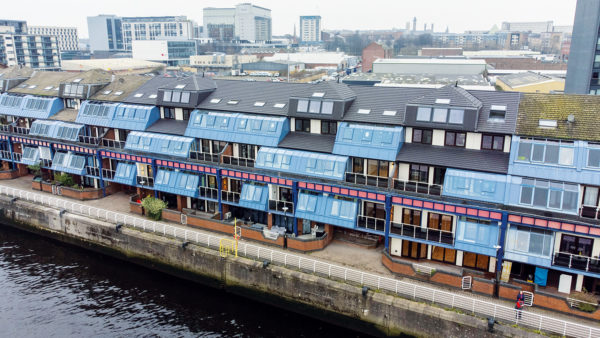
Could a new facade fire-testing alliance provide the market with a much-needed shake-up? Neil Gerrard reports.
After the Grenfell Tower disaster, the way cladding products are tested for fire resistance is under scrutiny like never before.
Since summer 2017, a government programme has identified 474 high-rise residential and publicly owned buildings with aluminium composite material (ACM) cladding unlikely to meet Building Regulations. More are likely to follow.
Meanwhile, the Hackitt review has criticised the scope and effectiveness of fire safety tests, and the limited number of testing centres. The main test standard, BS 8414, has also come in for criticism.
Against this backdrop, a new facade fire-testing alliance has been set up by safety consultant UL and the UK Fire Protection Association (FPA).
BS 8414 fire test
The two-part BS 8414 test dates back to 2002 and was revised in 2015. Also known as the “garage test”, because it is supposed to simulate a fire coming out of a garage and up the side of the building, it essentially measures fire spread up and slightly across a facade.
Alternatives to BS 8414 include a Swedish standard that is reasonably similar and a US one which is somewhat different. But for the most part, BS 8414 dominates in the UK.
The options on where to have products tested to BS 8414 are currently limited. BRE conducts the lion’s share of the testing, while there is also a new rig operated by Efectis in Northern Ireland, and another that tests to BS 8414 in Dubai.
BS 8414 fire test centres
- BRE, Garston, Hertfordshire
- Efectis, University of Ulster, Northern Ireland
- Thomas Bell-Wright Consultants, Dubai
Jonathan O’Neill, FPA managing director, says: “The Hackitt Review confirmed problems in the UK fire-testing market. This new venture aims to deliver the level of quality, expertise and experience required.”
So where are the failings in the current fire testing regime and what is likely to change?
For large-scale testing of cladding systems, the two-part BS 8414 standard (see box) is the most common test. Insurers, for one, are not happy with the state of play. In April, the Association of British Insurers (ABI) released details of research it commissioned the FPA to carry out, which it said exposed the “utter inadequacy” of the laboratory tests currently used to check the fire safety of building materials.
Call for real-world test conditions
In the case of tests on cladding, it warned that materials were sometimes tested as a sealed unit, whereas on a building they were likely to include gaps and cover a far more extensive area.
In its Hackitt submission, the ABI called for a reformed testing regime that replicates real-world conditions, and a ban on combustible materials. Hackitt stopped short of this, but the government quickly launched its own consultation on banning combustible cladding for high-rise residential buildings, with the findings expected to be announced in October.
An outright ban (on all buildings) is unlikely, according to Tom Roche, senior consultant with insurer FM Global. “Practically, I don’t think that is going to happen, but testing standards may become much tougher,” he says.
A concern for Roche is if cladding is combined with other products: “If you combine ACM and insulation, and add a weather-resistant barrier or vapour barrier, then there are enough combustibles in there to be concerned about.”
Abroad, FM Global performs its own test on cladding, a “parallel panel” test it claims is more stringent than those used in the UK.
Roche doesn’t see any major issues with the BS 8414 test. “Actually, BS 8414 is probably towards the top end of the international tests that are available,” he says. But he worries that few products undergo practical tests to BS 8414 and too many have been approved on the strength of desktop studies (which the government has already committed to ban).
“Normally tests are done by people who know what they are doing, with an understanding of fire testing and a good engineering background, but there are no real rules to make that happen. I’m not sure enforcement of our own regulations has been strong enough.”
Chris Miles, fire safety consultant, UL
“There is no real governance of desktop studies,” warns Chris Miles of UL. “People will test a relatively safe option, get a result, and then extrapolate from that. So a manufacturer could do a test and then an assessor could allow all sorts of changes from it.
“Normally tests are done by people who know what they are doing, with an understanding of fire testing and a good engineering background, but there are no real rules to make that happen.
“I’m not sure enforcement of our own regulations has been strong enough.”
Through its new alliance, UL will invest in the FPA’s existing facilities, with the aim of increasing the capacity and quality of large-scale fire testing of cladding and building systems to BS 8414. At the moment, UL is holding back while it awaits the results of the government’s consultation on banning combustible cladding.
“If the government decides on a complete ban there is no point doing any sort of large-scale testing,” says Miles.
There are also changes expected to BS 8414. When asked by CM, BRE said it couldn’t give a clear-cut answer on whether BS 8414 would still be relevant after the government’s consultation because it is a “fluid and complex area”.
It said: “We are pleased that the FPA and UL have decided to contribute to the future development of BS 8414 within the BSI standards process. They have put forward their views in the published ABI report and we are aware that there are wide ranging and often contradictory technical opinions to those expressed in that report, some of which are also in the public domain.
“We welcome this potential extra resource. Along with the new rig in Northern Ireland, this will help deal with the unprecedented demand for the test since Grenfell. Having new facilities that can test to the existing BS 8414 standard, which BRE will continue to do, will strengthen the fire safety sector as long as those facilities are UKAS accredited and operate within its tough quality framework.”
BRE pledged to work with all stakeholders to deliver the next version of BS 8414. What is still not clear though, is what that version will be, or how it will be enforced.
Comments
Comments are closed.









The focus post-Grenfell has been on cladding.
I’d be interested to know how the standards for curtain walling are being reviewed, as it seems that there is no guidance at all of any kind in the UK.
That a fire will melt through aluminium very fast, and a paltry BS 476 firestop between the floor and a curtain wall will then be ineffective seems obvious. But having repeatedly had a contractor argue the point of ‘show me where it says’ in BS 9999 (or anywhere else relevant) that anything more than a firestop to the back of the aluminium is required, I have to wonder why this design guidance is so lacking, given projects with curtain walling systems weren’t exactly invented yesterday?
That the USA has fire standards (ASTM E 2307) was actually a surprise to our facade consultant, who didn’t think anything was needed at all to achieve the 120 minutes compartmentation (integrity and insulation) our project requires.
So, with so many high rise projects now in London, when can we have clear guidance as to objective requirements?
Or do we need a major fire in a building spread through the curtain walling system before this is addressed?
I agree with your comment, having recently carried out a number of 8414 tests on systems using vented fire breaks that are currently being approved by building control on high rise buildings. They are failing when tested to 8414. These types of intumescent fire breaks fail to last 7 minutes, even the suppliers of these breaks confirm that they are combustible and have only been tested between two masonry walls.
The need of the hour is define and clarify responsibilities and liabilities. As an example who is held accountable if a building collapses? Or if rain water seeps inside the building. Or the plumbing or ductwork fails or does not last as promised.
Testing labs , as Chris points out have a primary role for creating data end evidence of how given materials supplied for testing behave.
Establishing a clearer knowledge of the supply chain within the construction industry would be a good starting point.
I have now commissioned and been present at 4 off AS5113 Assessments of the BS-8414 Fire Test. The AS5113 is certainly a more stringent assessment then the BR135, one in which the UK should consider. Whilst i read criticism of the same from time to time, “all” need to note if 100% PE ACM was subjected to this test when ACM was in its infancy (late 80,s), then we would not have lost so many souls. “Bench testing” allowed 100% PE onto the market.
Our tests are seeing “DNC” Insulation failing, DTS Sarking/Lining going up in smoke, whilst seeing the respected Alpolic F.R and other 70/30 ACM’s proving they do work, with no propagation of flame beyond the fire source.
However, like i have seen in the UK, and here in Australia, some manufacturers are being allowed to “fudge” their tests at the Private testing facilities.
Eg, fail on the first ($60 K) fail on the second (another 60 K) and miraculously (another $60 K) pass on their third test. Then all Industry see’s “we passed”, yet when you see the final “poor drawings”, in which the end user on site is to construct the same as tested, there has been so many changes, non typical fabrication and installation, the end result is twice the price to realize the same as “allowed” to be tested system.
Thank God, we have a Government owned “regulated” facility here in Australia (CSIRO) of whom has a new $4 Mill purpose built indoor facility. This team ensures what is being tested, how it is being installed, truly represents the manufacturers standard install details. No second goes here!
Industry needs to keep learning from a reputable testing facility, one in which provides a very high quality standard of reporting, eg very clear 3D Drawings, very clear everything ! Any one wanting a copy of our latest CSIRO test report of the BS8414 test, i am happy to email it to you ! [email protected]